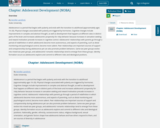
By Jennifer Lansford, Duke University. Adolescence is a period that begins with puberty and ends with the transition to adulthood (approximately ages 10–20). Physical changes associated with puberty are triggered by hormones. Cognitive changes include improvements in complex and abstract thought, as well as development that happens at different rates in distinct parts of the brain and increases adolescents’ propensity for risky behavior because increases in sensation-seeking and reward motivation precede increases in cognitive control. Adolescents’ relationships with parents go through a period of redefinition in which adolescents become more autonomous, and aspects of parenting, such as distal monitoring and psychological control, become more salient. Peer relationships are important sources of support and companionship during adolescence yet can also promote problem behaviors. Same-sex peer groups evolve into mixed-sex peer groups, and adolescents’ romantic relationships tend to emerge from these groups. Identity formation occurs as adolescents explore and commit to different roles and ideological positions.
- Subject:
- Psychology
- Material Type:
- Reading
- Author:
- Maura Krestar
- Date Added:
- 05/19/2021